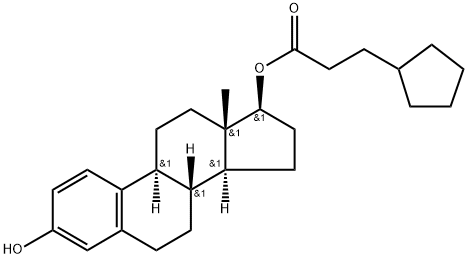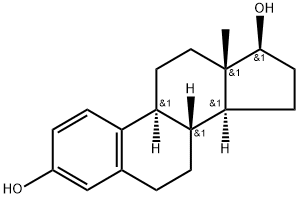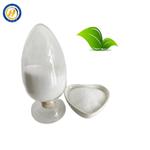Chemical Properties
Estradiol cypionate is a White to Off-White Solid. It is soluble in organic solvents such as ethanol, DMSO, and dimethyl formamide (DMF). The solubility of estradiol cypionate in ethanol is approximately 20 mg/ml and approximately 15 mg/ml in DMSO and DMF.
Originator
Depo-Estradiol,Upjohn,US,1952
Uses
Estradiol Cypionate is the cypionate salt form of estradiol, the most potent, naturally produced estrogen. Estradiol Cypionate is present in injectable contraceptive formulations. Used in hormone replacement therapy with potential for improving cognition in post-menopausal women.
Definition
ChEBI: Estradiol 17beta-cyclopentylpropionate is a steroid ester. It inhibits ET-1 synthesis via estrogen receptor.
Manufacturing Process
A solution of 80.0 grams (0.294 mol) of estradiol-17β in 860 ml of pyridine
was cooled in an ice-bath and 130.0 grams (0.81 mol) of
cyclopentanepropionyl chloride was added dropwise with stirring during a
period of about 20 minutes. The ice-bath was removed, stirring was continued
for 1 hour and the reaction mixture was allowed to stand at room temperature
overnight. The mixture was warmed on a steam bath and stirred for about 45
minutes, cooled and poured slowly onto about 1,000 grams of ice to which
had been added 330 ml of concentrated sulfuric acid. The precipitated product
was extracted with 400 to 500 mi of ether, and the extract was washed
successively with two 100-ml portions of cold 1 N sulfuric acid, two 100-ml
portions of saturated sodium carbonate solution and water until the pH was 7
and dried over anhydrous sodium sulfate. After removal of the drying agent,
the solution was concentrated to a volume of about 250 ml and an equal
volume of methanol was added.
After chilling overnight a total of 120.0 grams (78.5%) of estradiol 3,17β-
dicyclopentanepropionate was obtained which melted at 87° to 90°C. A
sample recrystallized from ether methanol for analysis melted at 90.5° to
91.5°C.
To a solution of 2.5 grams (18.1 mmol) of potassium carbonate in 25 ml of
water was added 225 ml of methanol followed by 5.0 grams (9.6 mmol) of
estradiol 3,17β-dicyclopentanepropionate. The mixture was stirred for 2?
hours at 202°C during which time some precipitation occurred. The mixture was poured into 700 ml of water with efficient stirring and the precipitated
solid was removed by filtration, washed with water and dried.
Recrystallization of the crude product from 80% methanol gave 3.16 grams
(83%) of estradiol 17β-cyclopentanepropionate melting at 148° to 151°C.
Recrystallization from benzenepetroleum ether raised the MP to 151° to
152°C.
brand name
depGynogen(Forest); Depo (Pharmacia & Upjohn).
Therapeutic Function
Estrogen
Biological Activity
estradiol cypionate is the 17 β-cyclopentylpropinate ester of estradiol, which inhibits et-1 synthesis via estrogen receptor.
Pharmacokinetics
Estradiol cypionate/medroxyprogesterone acetate is a combined injectable contraceptive containing 5 mg estradiol cypionate and 25 mg medroxyprogesterone acetate in microcrystalline aqueous suspension for once-monthly intramuscular administration. With this formulations, estradiol levels peak 2 to 3 days post-injection with average maximal circulating levels of about 250 pg/mL. The elimination half-life of estradiol with these formulations is 8.4 to 10.1 days, and circulating estradiol levels return to a baseline of about 50 pg/mL approximately 14 to 24 days post-injection
Side effects
The side effects of estradiol cypionate are the same as those of estradiol. The side effects of Estradiol Cypionate include breast tenderness and enlargement, nausea, vomiting, bloating, edema, headache, migraine, and melasma. High-dose estrogen therapy with estradiol cypionate injections may also cause an increased risk of thromboembolism, changes in blood lipid profile, increased insulin resistance, and increased levels of prolactin.
Safety Profile
An experimental
teratogen. Other experimental reproductive
effects. A steroid. When heated to
decomposition it emits acrid smoke and
fumes.
Mode of action
Estradiol cypionate diffuses through the cell membrane and binds to and subsequently activates the nuclear estrogen receptor found in the reproductive tract, breast, pituitary, hypothalamus, liver, and bone. The activated complex binds to the estrogen response element on the DNA and activates the transcription of genes involved in the functioning of the female reproductive system and secondary sex characteristics.
Toxics Screening Level
The ITSL for estradiol cypionate has been changed from 0.04 μg/m3 to 0.1 μg/m3 based on an annual averaging time.






